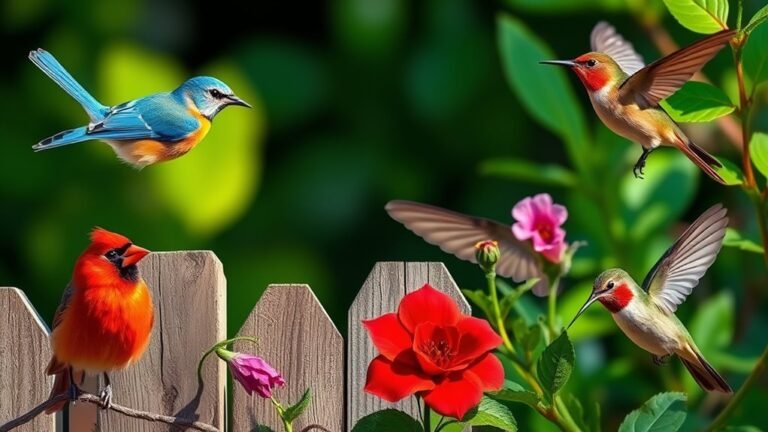Winter Backyard Birds Guide
As winter arrives, your backyard becomes a vital space for many bird species. Watching these birds can help you learn about their habits and how they survive the cold. Northern Cardinals and Dark-eyed Juncos will visit your feeders if you set them up correctly. Knowing the right supplies and methods can improve your birdwatching and support the birds' health.
Here are some simple strategies to make your yard a welcoming home for birds:
- Choose the Right Feeders: Select feeders that attract different bird species. Tube feeders work well for small birds, while platform feeders are great for larger ones.
- Use Quality Birdseed: Offer seeds that these birds enjoy. Black oil sunflower seeds are a favorite for many songbirds, including cardinals and juncos.
- Keep Feeders Clean: Regularly clean your feeders to prevent disease among birds. Rinse them with hot water and let them dry completely before refilling them.
- Provide Fresh Water: Birds need water, even in winter. Place a birdbath in your yard and ensure it doesn't freeze. You can use a heated bath to keep the water liquid.
- Create Shelter: Plant shrubs and trees to provide shelter. Birds benefit from having places to hide from predators and find warmth during cold nights.
By following these strategies, you can create a welcoming environment for winter birds in your backyard. Enjoy the beauty of nature and the joy of birdwatching this winter!
Key Takeaways
- Identify common winter birds like Northern Cardinals, Dark-eyed Juncos, and Goldfinches that frequent backyards during the season.
- Provide high-quality seeds, such as sunflower and safflower, to attract a variety of bird species effectively.
- Use durable, weather-resistant feeders, and place them strategically near trees for protection against predators.
- Create a bird-friendly environment with native plants, evergreens, and sheltering structures for food and safety.
- Engage kids in birdwatching through observation, nature journals, and checklists to foster an appreciation for wildlife.
Common Winter Birds to Attract

As winter brings cold weather, you can attract many birds to your backyard by offering the right food and environment.
Look for Northern Cardinals with their bright red feathers. They often move through bare trees. Dark-eyed Juncos, small gray birds, like to feed on the ground, looking for seeds. Goldfinches may not be as colorful in winter, but their presence is noticeable.
To enjoy birdwatching, be patient. Stay still, and you may see them more closely. As birds change their migration patterns, they depend on backyards for food.
By creating a welcoming space, you help the birds and feel a stronger connection to nature. This effort can make your outdoor space lively and satisfying.
Enjoy the beauty of these winter visitors!
Essential Feeding Supplies for Winter
To attract and support winter birds in your backyard, use effective feeding supplies. Start with airtight containers to keep seeds fresh and prevent spoilage during the cold months.
Select a variety of high-quality seeds, such as sunflower and safflower, to attract different bird species.
Place feeders in sheltered areas to give birds a sense of safety from predators. Clean feeders regularly to reduce the risk of disease and promote healthy bird populations.
Observe bird feeding patterns each day and adjust your seed offerings based on which species visit most frequently.
Best Bird Feeders for Cold Weather

Winter can be tough for birds, but choosing the right feeders can help attract different species to your yard.
Look for durable, weather-resistant feeders that offer protection from snow and rain. Tube and hopper feeders work well because they keep seeds dry and easy for birds to access.
When placing your feeders, select spots that are visible and near trees or bushes. This provides birds with cover against predators.
To keep squirrels from stealing your food, consider using squirrel-proof feeders. Make sure to set your feeders at different heights to invite a variety of bird species to your yard.
Types of Birdseed for Winter Feeding
Choosing the right birdseed helps attract a variety of birds in winter. Different birds like different seeds, so offering several types will bring more visitors.
Here are some great options for your feeders:
- Sunflower seeds: Many birds, like cardinals and chickadees, love these seeds.
- Suet cakes: These provide energy and attract woodpeckers and nuthatches.
- Mixed blends: These include grains, seeds, and nuts, appealing to many birds.
- Mealworms and peanut butter: These protein-rich foods are favorites of bluebirds and wrens.
Store your birdseed in a cool, dry place to keep it fresh.
Creating a Bird-Friendly Backyard

To attract winter birds to your backyard, plan carefully. Start with bird-friendly plants like conifers and native shrubs.
These plants provide food and shelter. They produce berries and create good nesting spots for birds during winter. Add evergreens to offer protection from harsh weather, giving birds a safe place during storms.
Also, leave natural debris, like fallen branches and leaf piles. This debris provides shelter and promotes insects that birds eat.
Importance of Fresh Water for Birds
As winter approaches and temperatures fall, birds in your backyard need access to fresh water. Many natural water sources may freeze, so having a reliable water supply is vital for their hydration and feather maintenance.
Here are some tips to ensure your birdbath is effective:
- Maintain your birdbath: Regularly remove ice and debris to keep the water accessible.
- Choose a heated birdbath: This will prevent the water from freezing.
- Proper placement: Put your birdbath in a visible and accessible location for birds.
- Refresh the water: Change the water every few days to keep it clean and appealing.
Winter Birds' Behavior and Feeding Habits
In winter, when snow covers the ground and temperatures drop, birds change how they behave and eat to survive. Many species flip over leaves or peck at tree bark to find hidden seeds and insects.
Birds often gather in flocks, which helps them stay safe and find food more easily. These groups create a lively scene, as the birds interact and communicate with each other.
You can help these birds thrive by putting out feeders filled with various seeds. By understanding their behavior, you can enjoy the beauty of nature in your backyard.
Identifying Backyard Birds by Appearance
Many birds visit backyards in winter. Identifying them can be fun and rewarding. Focus on their sizes and feather colors. These details help distinguish different species.
Here are some traits to consider when observing winter birds:
- Sizes: Birds vary from small bushtits to larger woodpeckers.
- Feather Colors: Look for the vibrant red cardinals and the muted browns of sparrows.
- Patterns: Some birds, like the American tree sparrow, have distinct markings.
- Beak Shapes: Different beaks serve different diets. For example, finches have stout beaks.
With time and practice, you can improve your birdwatching skills. Enjoy connecting with nature through this rewarding activity!
Popular Winter Bird Species
Many birds find shelter in backyards during winter. Some species are particularly resilient in colder climates.
The Northern Cardinal is notable for its bright red feathers. The Dark-eyed Junco has a gray body and white belly and often forages for seeds on the ground.
Chickadees are friendly and known for their "chick-a-dee-dee-dee" call. They often eat from people's hands.
Blue Jays have striking blue plumage and loud calls, adding excitement to birdwatching. Learning to identify these species can help you connect with them. This connection can create a sense of belonging in the diverse bird community in your backyard.
Tips for Photographing Winter Birds
To take great photos of winter birds, focus on light and timing. These factors are crucial for your pictures. Winter light can make birds' colors stand out against the white snow.
Here are some tips for capturing the best shots:
- Set your camera for fast shutter speed to capture action.
- Take photos during golden hours—early morning or late afternoon—when the light is softer and colors are richer.
- Use a telephoto lens to get close-up shots without bothering the birds.
- Lower the ISO setting to reduce noise, utilizing the natural light.
Maintaining Bird Feeders in Winter
Capturing beautiful images of winter birds is rewarding.
To enrich your experience, take care of your bird feeders during winter. Check your feeders regularly to keep them clean and mold-free. This helps the health of visiting birds. Use high-energy foods like sunflower seeds and suet to attract more birds. Place feeders in sheltered spots to shield them from harsh weather.
Refill your feeders often since natural food is hard to find in winter. By following these tips, you'll create a friendly environment that helps you connect with your feathered friends all winter long.
Creating Shelter for Backyard Birds
Creating shelter for backyard birds is important for their survival during winter. Birds need protection from cold winds and predators, and you can help them with suitable shelters.
Here are some effective options for winter nesting:
- Birdhouses: Build birdhouses using insulated wood or natural materials to create warm spaces.
- Native shrubs: Plant evergreen bushes that offer dense cover and protect birds from harsh weather.
- Leaf piles: Stack leaves in your yard; many birds use them for warmth and insulation.
- Thickets: Encourage dense growth of native grasses or brush to provide shelter from difficult conditions.
Each of these options helps birds find safety and warmth during the cold months.
Engaging Kids in Bird Watching
How do you spark a child's interest in nature? Start birdwatching!
Create a comfortable viewing spot with binoculars. Ask your child to watch and notice the activities of winter birds. Encourage them to identify the types and colors of the birds they see.
Provide a nature journal so they can draw and write about their observations. This makes every sighting feel like a fun discovery.
To make it even more exciting, make a checklist of common backyard birds and see if they can spot and name each one.
These activities help children appreciate nature and bring families closer as they enjoy the wonders of birds together.
Frequently Asked Questions
How Can I Tell if a Bird Is Sick?
To tell if a bird is sick, look for clear signs. Watch for lethargy, fluffed feathers, or discharge from the eyes or nose. Make a checklist of symptoms to help track your bird's behavior. These signs can help you notice health issues early, allowing you to seek care before problems get worse. Observe closely and act quickly to ensure your bird stays healthy.
Do Different Birds Prefer Different Feeding Times?
Different birds have unique feeding times. Some prefer to eat at dawn, while others are most active during midday or dusk. Understanding these preferences can enhance your connection with nature. By observing birds during these times, you can enjoy watching their distinct feeding habits. Whether you're a seasoned birdwatcher or just starting, knowing when birds feed adds to the enjoyment of your experience.
What Are the Best Plants for Attracting Winter Birds?
To attract winter birds, plant native shrubs that provide habitat and food. Use winter berries like holly and winterberry. These plants not only supply nourishment but also create a friendly space for various bird species. Adding these plants to your garden can help bring colorful birds to your yard during the colder months. Enjoy watching them thrive in a welcoming environment.
How Can I Keep My Feeders Clean During Winter?
To keep your feeders clean during winter, use vinegar and brushes for cleaning. Wash your feeders regularly. This prevents disease and helps your birds stay healthy in your backyard. Enjoy watching your feathered friends as they thrive in a clean habitat.
Are There Any Hazards I Should Watch for in My Backyard?
While watching your backyard, look out for dangers like predators that can harm visiting birds. Place your bird feeders in safe spots to protect your feathered friends while they eat.

Hello, I’m Amelia White, the founder of birdsfanatic.com. As a lifelong bird enthusiast and spiritual seeker, I’ve always been fascinated by the mystical connections between birds and the human experience. On this site, I share my knowledge and insights into the symbolic meanings and spiritual significance of various bird species, exploring their roles in mythology, folklore, and cultural traditions. Join me on this journey into the world of birds, where we’ll discover the hidden wisdom and guidance that these magnificent creatures have to offer.







